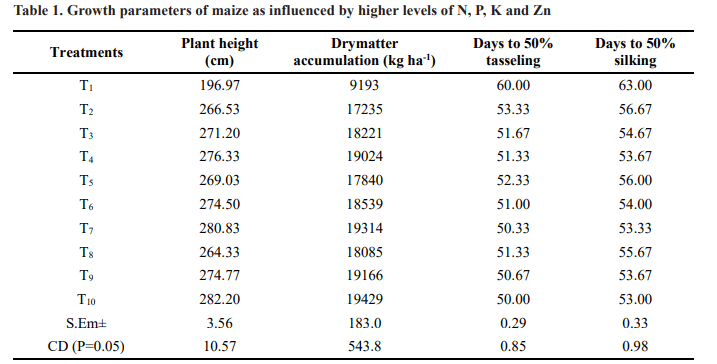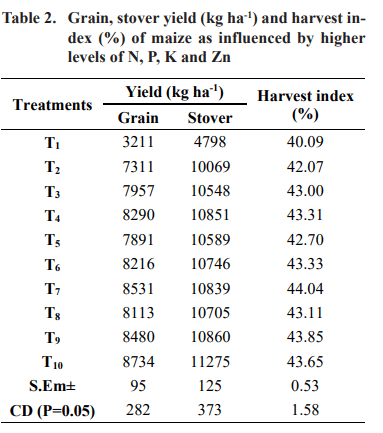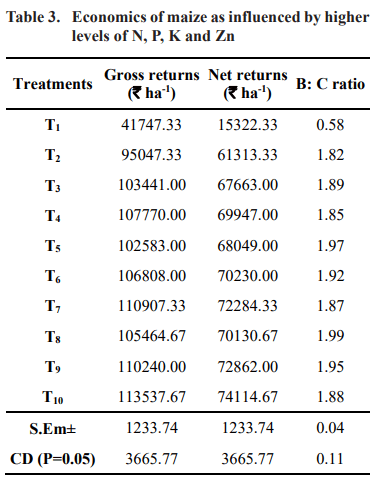Effect of Higher Levels of Nutrients on the Growth, Yield and Economics of Maize (Zea Mays L.)
0 Views
K. SATHISH BABU, P.V. RAMESH BABU, M. SRINIVASA REDDY* AND P. KAVITHA
Department of Agronomy, Agricultural College, Mahanandi
ABSTRACT
A field trial was conducted at Agricultural College Farm, Mahanandi on sandy loam soils to know the response of maize to higher levels of NPK and Zn nutrition on growth, economics, yield and yield parameters. The experiment was laid out in randomized block design with 10 treatments consisting of three higher levels of major nutrients and six treatments of higher levels of major nutrients in combination of Zinc and each treatment was replicated thrice. Result showed that application of 350-100-100 kg N- P2O5-K2O ha-1 along with foliar application of 0.2% ZnSO4 at 15 and 25 DAS (T10) resulted in higher plant height, total drymatter accumulation. minimum days to 50 percent tasseling and silking, maximum grain yield and stover yeild. However harvest index (43.85) was significantly higher with the application of 350-100-100 kg N-P2O5-K2O ha-1 along with foliar application of 0.2% ZnSO4 at 15 DAS (T7). Higher gross returns (` 113537.67 ha-1) and net returns (` 74114.67 ha-1) were recorded with the application of 350-100-100 kg N-P2O5-K2O ha-1 along with foliar application of 0.2% ZnSO4 at 15 and 25 DAS (T10). The highest B: C ratio was obtained with application of 250-60-60 kg N-P2O5-K2O ha-1 along with foliar application of 0.2% ZnSO4 twice at 15 and 25 DAS (T8).
KEY WORDS:
Growth, economics, maize, nutrients and yield.
INTRODUCTION
Maize (Zea mays L.) is the third most import cereal crop of world and india after wheat and rice. Globally, maize is known as ‘‘Miracle crop’’ because of its highest genetic yield potential than other cereals. Maize is the third most important cereal crop cultivated in an area of 150 m. ha in 160 countries contributes to 36 per cent (78.2 m t) in the total grain production of the world. In India, maize is cultivated in area of 9.23 m ha with production of 23.67 m t with an average yield of 2.56 t ha-1 (Anonymous, 2016). In Andhra Pradesh, maize is cultivated in an area o f 4.07 lakh ha with a production of (Anonymous, 2016). By 2020, the requirement of maize for various sector will be around 100 m t which is a challenging task for us to improve the factors that affects production and productivity of maize production from the present level (Seshaiah, 2000).The concept of balanced nutrient management paves the way for optimum nutrient supply to realize full yield potential of maize. However, continuous use of imbalanced fertilizer can decline in soil fertility and yield reduction. Keeping these points in view, the present experiment was conducted to investigate the influence of higher levels of NPK in combination of micronutrient especially Zn.
MATERIAL AND METHODS
A field experiment was conducted during rabi season of 2015-16 in the sandy loam soil with slightly alkaline pH (7.98), low in organic carbon (0.46%), medium in available nitrogen (298 kg ha-1), high in available phosphorus (48.12 kg ha-1), available potassium (687.6 kg ha-1) and sufficient in available zinc (1.32 ppm). The experiment was laid out in a randomized block design with ten treatments replicated thrice. The treatment details are T : Control, T : 250-60-60 kg N-P O -K O ha-1, T : 300-80-80 kg N-P2O5-K2O ha-1, T4: 350-100-100 kg N-
P2O5-K2O ha-1, T5: T2 + Foliar application of 0.2% ZnSO4 at 15 DAS, T6: T3 + Foliar application of 0.2% ZnSO4 at 15 DAS, T7: T4 + Foliar application of 0.2% ZnSO4 at 15 DAS, T8: T2 + Foliar application of 0.2% ZnSO4 at 15 and 25 DAS, T9: T3 + Foliar application of 0.2% ZnSO4 at 15 and 25 DAS, T10: T4 + Foliar application of 0.2% ZnSO4 at 15 and 25 DAS. Maize hybrid ‘P3396’ was used in the study. The amount of nitrogen in the form of urea was applied in three equal splits i.e., at sowing, knee height stage and tasseling stage. The complete dose of phosphorous and potash was applied as per treatment
through SSP and MOP as basal at the time of sowing and In the case of foliar feedings of zinc, it was given at 15 and 25 days after sowing. Data on growth parameters yeild attributes and yield were recorded and subjected to stastical analysis and economics were worked out based on prevailing market price.
RESULTS AND DISCUSSION
Higher levels of nitrogen, phosphorus, potassium and foliar application of Zn significantly influenced the plant height. Slightly higher plant height was observed with T10 (T4 + Foliar application of 0.2% ZnSO4 at 15 and 25 DAS), which was at par with T9 (T3 + Foliar application of 0.2% ZnSO4 at 15 and 25 DAS), T7 (T4 + Foliar application of 0.2% ZnSO4 at 15 DAS), T6 (T3 + Foliar application of 0.2% ZnSO4 at 15 DAS) and T4 but significantly superior over the T1 (Control), remaining treatments are comparable with each other. This might be due to elevated levels of nutrient supply, enabled the crop to absorb adequate amounts of major nutrients at the peak physiological requirement moreover balanced fertilization, particularly when ample amounts of major nutrients are supplemented with vital micronutrients like Zn, enabled rapid cell division and cell elongation that might have resulted in improvement in plant height. Similar results were reported by various researchers like Gupta et al. (2014) and Nithin Krishna et al. (2015).
Drymatter accumulation of maize increased progressively and significantly due to higher levels of nitrogen, phosphorus, potassium and foliar application of Zn. Higher drymatter accumulation was observed with T10. However at par with the treatments T9 (T3 + Foliar application of 0.2% ZnSO4 at 15 and 25 DAS), T7 (T4 + Foliar application of 0.2% ZnSO4 at 15 DAS), T6 (T3 + Foliar application of 0.2% ZnSO4 at 15 DAS), T4 (350- 100-100 kg N-P2O5-K2O ha-1) and the significantly lowest was recorded with T1 (Control). Increased drymatter accumulation due to combined effect of NPK and Zn showed synergistic effects of nitrogen uptake rate and lead to extending the LAI resulting in better interception and utilization of radiant energy, leading to higher physiological activity of leaves, which ultimately resulted in higher accumulation of drymatter. Moreover application of Zn to foliage helped to maintain higher auxin content, which enabled the plant to grow taller and led to intercept more light further, maintenance of high chlorophyll content might have helped in better photosynthetic activity, which resulted in higher drymatter production. These findings are in collaboration with the results of Jeet et al. (2014), Paramasivan et al. (2014) and Manwar and Mankar (2015).
The maximum grain yield (8734 kg ha-1) and stover yield (11275 kg ha-1) was obtained with the treatment that received 350-100-100 kg N-P2O5-K2O ha-1 along with

foliar application of 0.2% ZnSO4 at twice 15 and 25 DAS (T10) and significantly superior over othe rest of treatments tried in the study except the grain yield obtained with the treatments of T9 (T3 + Foliar application of 0.2% ZnSO4 at 15 and 25 DAS) and T7 (T4 + Foliar application of 0.2% ZnSO4 at 15 DAS) and T6 and T8. However, harvest index (43.85) was significantly higher with the application of 350-100-100 kg N-P2O5-K2O ha-1 along with foliar application of 0.2% ZnSO4 at 15 DAS (T7) and significantly superior over the T2 (250-60-60 kg N-P2O5-K2O ha-1) and control (T1). Highest grain, stover yield and harvest index was might be due to better translocation of photosynthates from source to sink, which resulted in higher growth attributing characters. These results are in conformity with the findings of Nandita Jena et al. (2013) and Manasa and Devaranavadagi (2015).
Economics
The higher gross and net returns (` 113537.67 ha-1 and ` 74114.67 ha-1, respectively) was recorded with application of 350-100-100 kg N-P2O5-K2O ha-1 along with 0.2% ZnSO4 as foliar spray twice at 15 and 25 DAS (T10) and significantly superior over control (T1). However, application of 250-60-60 kg N-P2O5-K2O ha-1 along with foliar application of 0.2% ZnSO4 at 15 and 25 DAS (T8) resulted in significantly higher B: C ratio (1.99) and superior over the application of 250-60-60 kg N-P2O5- K2O ha-1 alone (T2) and control (T1). These findings are in conformity with those of Kumar et al. (2015).
CONCLUSION
From, the above investigation, it is clearly indicated that the higher level of nitrogen, phosphorus, potassium along with foliar application of Zn had a significant influence in increasing growth and yield of maize was with applicationof 350 : 100 : 100 kg NPK ha-1 along with foliar application of 0.2% ZnSO4 at 15 and 25 DAS (T10). However, the economic yield was obtained with application of 250 : 60 : 60 kg NPK ha-1 along with foliar application of 0.2% ZnSO4 at 15 and 25 DAS (T8). It is therefore concluded that the better yields can be acheieved in maize with application of 250:60:60 kg NPK ha-1 alongwith foliar application of 0.2% ZnSO4 at 15 and 25 DAS (T8).


LITERATURE CITED
Anonymou, 2016. http://www.iimr.res.in.
Jeet, S., Singh, J.P., Kumar, R and Om, H. 2014. Response of nitrogen and sulphur levels on productivity and profitability of QPM hybrid (Zea mays) under dryland condition of Eastern Uttar Pradesh. Indian Journal of Agricultural Sciences. 84(5): 589-94.
Manasa, L.P and Devaranavadagi, S.B. 2015. Effect of foliar application on growth, yield and nutrient uptake of maize. Karnataka Journal of Agriculture Sciences. 28(4): 474-476.
Manwar, B and Mankar, D.D. 2015. Effect of land configuration and fertilizer management in Kharif maize (Zea mays L.). Journal on Soils and Crops. 25(1): 220-225.
Jena, N., Vani, K.P., Rao, P., Srinivas and Shankar, S. 2013. Performance of quality protein maize (QPM) on quality, yield and yield components as influenced by nutrient management. Journal of Progressive Agriculture. 4(2): 72-74.
Krishna, M.N., Reddy, M.S., Reddy, S.T and Kavitha, P. 2015. Effect of Nitrogen levels and planting patterns on growth parameters, yield attributes and yield of maize. Research Journal of Agricultural Sciences. 6(6): 1301-1304.
Paramasivan, M., Malarvizhi, P and Thiyageshwar, S. 2014. Effect of balanced nutrition on nitrogen-use efficiency, N balance and productivity of maize (Zea mays) in Inceptisol and Alfisol of Tamil Nadu. Indian Journal of Agronomy. 59(2): 289-294.
Kumar, R., Bohra, J.S., Singh, A.K and Kumawat, N. 2015. Productivity, profitability and nutrient -use efficiency of baby corn (Zea mays) as influenced of varying fertility levels. Indian Journal of Agronomy. 60(2): 285-290.
Gupta, V., Sharma, A., Kumar, J., Abrol, V., Singh, B and Singh, M. 2014. Effects of integrated nutrient management on growth and yield of maize (Zea mays L.) – gobhi sarson (Brassica napus L.) cropping system in sub-tropical region under foothills of north- west Himalayas. Bangladesh Journal of Botany. 43(2): 147-155.
- Genetic Divergence Studies for Yield and Its Component Traits in Groundnut (Arachis Hypogaea L.)
- Correlation and Path Coefficient Analysis Among Early Clones Of Sugarcane (Saccharum Spp.)
- Character Association and Path Coefficient Analysis in Tomato (Solanum Lycopersicum L.)
- Survey on the Incidence of Sesame Leafhopper and Phyllody in Major Growing Districts of Southern Zone of Andhra Pradesh, India
- Effect of Organic Manures, Chemical and Biofertilizers on Potassium Use Efficiency in Groundnut
- A Study on Growth Pattern of Red Chilli in India and Andhra Pradesh

